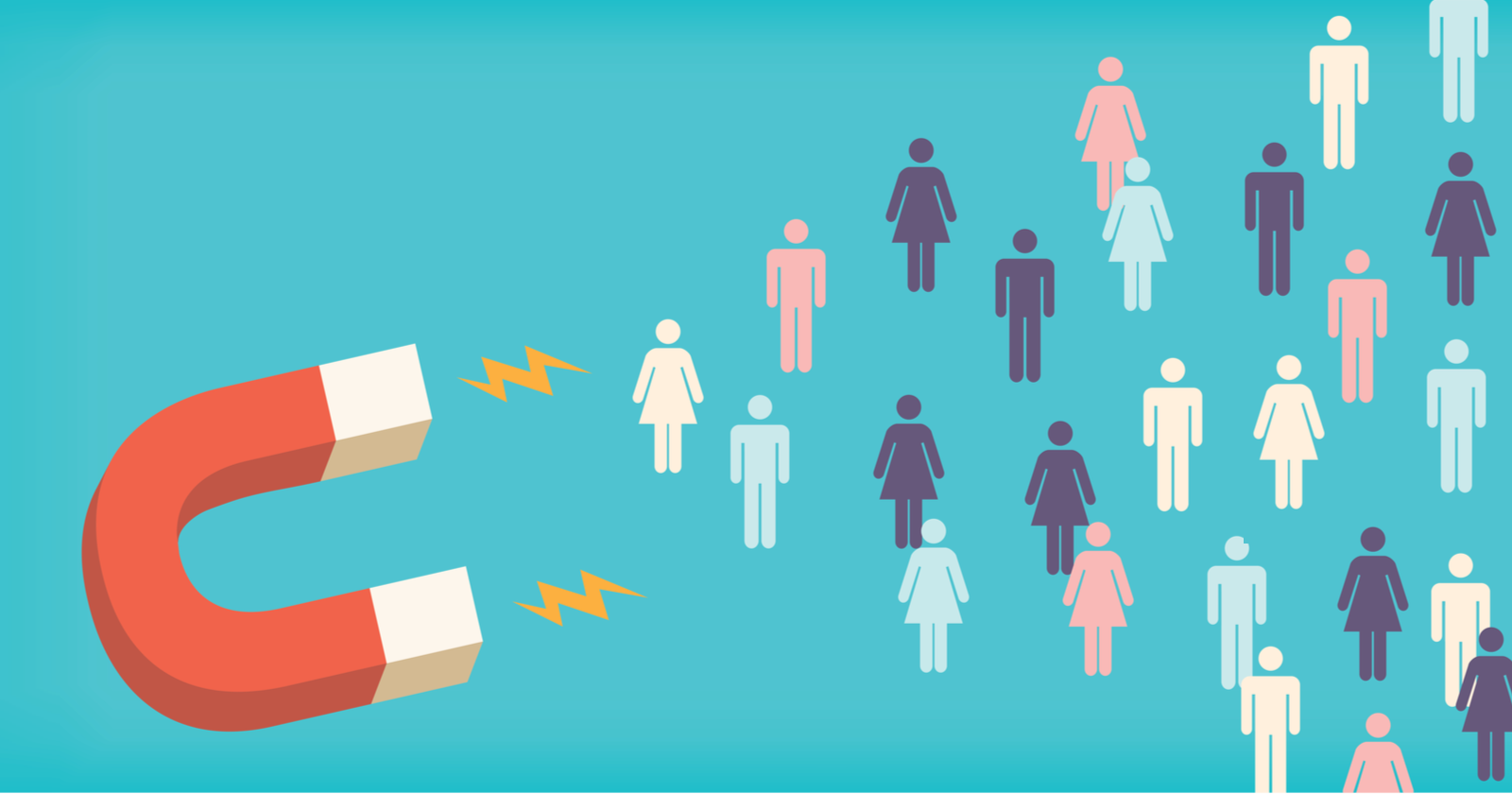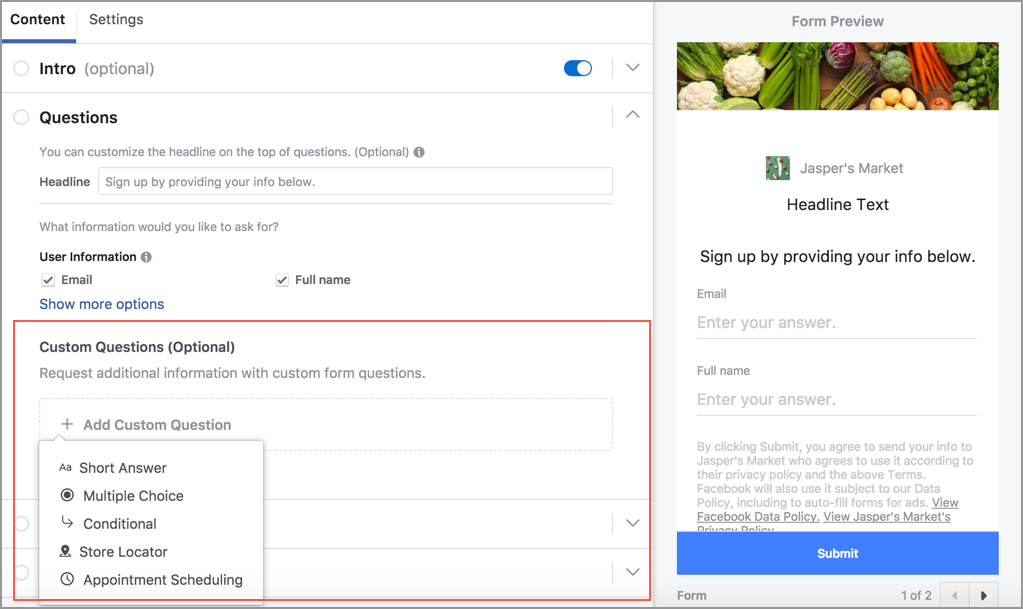I have worked with B2B advertisers for nearly my entire PPC career. During this time, social platforms have introduced several great features for B2B advertising and lead generation.
Below are a few of my favorite lead gen tactics for paid social platforms. We will be looking at Facebook and LinkedIn exclusively because these are two of the biggest social platforms for lead gen.
1. Lead Gen Form Ads
This seems like an obvious recommendation, but I have encountered several B2B advertisers who have not leveraged one-click lead forms.

Why You Should Use This Feature
This ad type automatically pre-fills the form with user data, making it as easy as one click for a user to fill in your form.
Thanks to the ease of use and customization capabilities, these ads are great for anything from content promotion to demo signups (and even beyond traditional lead gen).
Some advertisers choose to employ additional fields on their lead forms that require the user to engage more with the form.
In addition to gathering more information about the user, additional fields can also help with prequalifying leads and learning more about where users are in the buyer’s journey.
Facebook lead gen forms allow advertisers to create up to 15 custom questions.
LinkedIn lead gen forms allow advertisers to select up to 12 fields and utilize custom questions.
How to Use This Feature
Lead gen forms are an easy ad type to set up. There is no landing page needed, only the form fields and any supporting information you want to be included on the form itself.
In Facebook, lead ads can be created in Ads Manager or from a Page. A new campaign simply needs to be set to the Lead Generation objective to utilize lead ads. Additional information on lead ad creation can be found on Facebook Ads Help Center.
In LinkedIn, lead gen forms can be utilized in new Sponsored Content or Sponsored InMail campaigns as long as the campaign objective is set to lead generation.
More information about setting up lead gen campaigns and forms can be found on LinkedIn’s Marketing Solutions Help.
Pain Points with Lead Gen Forms
One important detail to remember when using lead forms is that Facebook allows you to retarget users who have interacted with your forms using engagement audiences.
LinkedIn does not offer the ability to retarget to users who have interacted with your lead forms (as of the date of publication), so you’ll want to take this into account when planning to use forms in a campaign.
The most common hang-up I see advertisers have is the ability to easily integrate these leads into their back-end systems.
Both LinkedIn and Facebook, in order to gather the leads generated from this ad type, require the advertiser to download an Excel CSV of user data.
In Facebook especially, one problem is that lead data has an expiration date of 90 days. Because of this, it’s recommended to download lead data at least once a week, more often if feasible.
An easy workaround to manually downloading lead data is using a third-party connection tool, such as Zapier.
Zapier is affordable, starting at $20 per month. It also has a multitude of options for integrating and automating the process of downloading lead data and uploading to your CRM or marketing automation system.
2. Lookalike Audiences
The ability to find additional users who are similar to your target audience is, in my opinion, one of the best features available on social platforms.
Both Facebook and LinkedIn have this feature, but the detail of how each platform’s feature works is a bit different from one another.
Lookalike Audiences on Facebook
Facebook’s lookalike feature is available for custom audiences (not created from your pixel data), mobile app data, or fans of your page. As long as you’re actively serving ads to the audience, the list will automatically refresh every 3-7 days.
Facebook allows you to choose the size of the audience, depending on how broad and large you want your audience.

Lookalike Audiences in LinkedIn
Lookalikes are a new feature in LinkedIn, just being released to all advertisers in March 2019.

For those of you who haven’t leveraged lookalikes in LinkedIn yet, there are a couple of differences from Facebook.
There isn’t an option for audience size, but the LinkedIn lookalike audiences do only match to recently active users.
Adding additional targeting overlayed on your lookalikes like Job Function, Job Title or Seniority will help to refine your reach.

You cannot use audience expansion with lookalike audiences in LinkedIn. You’ll also need to recreate new audiences to refresh and capture new members regularly.
Why You Should Use This Tactic
Lookalike audiences, coupled with exclusion lists, can help you identify additional qualified customers who potentially haven’t filled out their profile with their job title, company, or interests.
How to Use This Tactic
There are a few audiences I like to make from the get-go.
- The first is based on long-term or repeat customers. In Facebook, typically conversion rates are better with smaller lists, but since those lists are smaller, you may see performance begin to taper off more quickly than if you create a 3-4% sized list.
- The second list I create is a lookalike list shaped from unqualified leads. For many B2B clients, these folks are often small business owners, students, or folks doing research who aren’t looking to purchase.
- When I start to see dwindling results from the list created from customers, I’ll create a list from qualified MQLs, Opportunities and other sales-accepted leads that are still in the pipeline.
- Exclusions are also important. In the event of overlap from users I’ve already reached in the customer list, I’ll exclude the initial customer lookalike list, newsletter lists, and converters.
3. Account Based Marketing Lists in LinkedIn
Account Based Marketing, or ABM, has been a hot topic in the B2B world for a few years now.
The introduction of LinkedIn’s Matched Audiences allows advertisers to target contact lists, account lists, and website retargeting (in addition to recently adding lookalike audiences).
You can upload a list of company names and website URLs for matching. The recommended size is 1,000 companies, with 300 needed to be matched for targeting.
For contact lists, 10,000 contacts are recommended with 300 needed for targeting.
Why You Should Use This Tactic
If your sales team has a target account list for upload and matching in LinkedIn, that is a great way to get started targeting their most coveted accounts.
Similar to lookalikes, adding additional job titles, seniority, and/or job function layers is also recommended for further defining your audience.
How to Use This Tactic
For companies who may not have as clear a targeted list as outlined above, this next option will be a little more initial legwork but can have the same payoffs.
Especially for advertisers looking to reach enterprise-level businesses, creating a CSV file of Fortune 500 or Fortune 1000 companies for matching in LinkedIn can be especially useful.
This information is easily found with a couple of Google searches.
Given the size of many of the Fortune 500 and 1000 companies, I always recommend keeping up with uploading exclusion email and company lists for the clearest data and the best use of your budget.
4. Nurture Funnels
Setting up a nurture funnel can seem like a big undertaking. With a little planning and organized audience usage, this can be a good use of your paid social budgets.
Why You Should Use This Tactic
This is an organized means to assist lead movement through the funnel.
When coupled with sales and other marketing strategies (including ABM and/or lookalike audiences), this is an effective way to stay in front of potential customers.
How to Use This Tactic
I would recommend starting with a relevant (and if possible, high performing) content offer to kick-off the funnel.
Creating audiences based on users who have hit specific pages throughout your funnel will allow for easier audience targeting and exclusions.
For a B2B SaaS client, the nurture funnel could look as follows:
Cold Audience
- Target: Job title targeting, interest targeting, company lists.
- Ad: Content offering pertaining to individual industries.
- Exclude: Converters, current customers email list/company list, users who have hit pages in other parts of the funnel.
Warm Audience
- Target: Converters of content offering.
- Ad: Second content offer.
- Exclude: Converters, current customers email list/company list, demo page visitors, current site retargeting lists.
Hot Audience
- Target: Converters of previous content or who hit the demo page but did not convert.
- Ad: Demo offer.
- Exclude: Converters, current customers email list/company list, site retargeting lists.
Additional steps can be added or removed, depending on goals, calls-to-action, etc.
From here, you’ll want to make sure to properly target and exclude users from one level of the funnel to the next so that you’re not double-dipping.
Depending on the number of campaigns and levels in your funnel, this can get confusing. But it is a necessary step for proper tracking and as to not confuse and overload the user with many calls-to-action.
While lead forms often seem attractive for these campaigns, you’ll need to take into account the fact that LinkedIn does not offer engagement audiences.
That makes retargeting more difficult without users hitting your site. You’ll need to get creative and consider uploading email lists or account lists once there are enough users.
5. Webinar & Event Promotion
In addition to content and demo promotions for B2B advertisers, webinars and event promotion are another great way to generate leads from your paid social efforts.
How You Can Use This Tactic for Webinars
Webinars are a great way to engage with your target audience in a different capacity than a content offer.
The webinar can be pre-recorded or a live event. It’s always my recommendation that clients record any webinars for future on-demand offerings.
How You Can Use This Tactic With Events
Events are a great way for your company to engage with potential customers and/or repeat customers.
Coupling up email marketing, cold calling and other marketing efforts with paid social efforts can be a great way to get the word out about an event.
Given the time and money that goes into planning an in-person event, it’s worth it to spend a few extra dollars locking in some attendees.
More Resources:
- 7 Ways to Use Facebook Lead Gen Ads You May Not Have Thought Of
- How to Build a Free Facebook Messenger Chatbot for Lead Generation
- How to Advertise on LinkedIn in 2019: A Beginner’s Guide
Image Credits
All screenshots taken by author, May 2019






